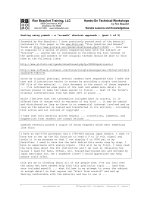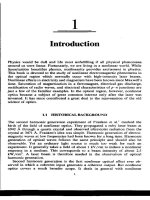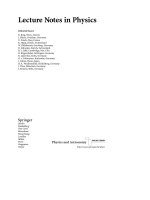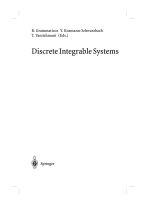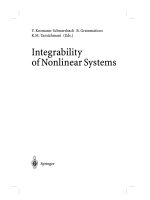- Trang chủ >>
- Khoa Học Tự Nhiên >>
- Vật lý
kosmann-schwarzbach y., grammaticos b., tamizhmani k.m. (eds.) integrability of nonlinear systems (springer lnp 638, 2004)(342s)
Bạn đang xem bản rút gọn của tài liệu. Xem và tải ngay bản đầy đủ của tài liệu tại đây (1.51 MB, 342 trang )
Y. Kosmann-Schwarzbach B. Grammaticos
K.M. Tamizhmani (Eds.)
Integrability
of Nonlinear Systems
13
Editors
Yvette Kosmann-Schwarzbach
Centre de Mathématiques
École Polytechnique Palaiseau
91128 Palaiseau, France
Basil Grammaticos
GMPIB, Universit
´
e Paris VII
Tour 24-14, 5
e
étage, case 7021
2 place Jussieu
75251 Paris, France
K. M. Tamizhmani
Department of Mathematics
Pondicherry University
Kalapet
Pondicherry 605 014, India
Y. Kosmann-Schwarzbach, B. Grammaticos, K. M. Tamizhmani (eds.), I ntegrabili ty of
Nonlinear Systems, Lect. Notes Phys. 638 (Springer-Verlag Berlin Heidelberg 2004), DOI
10.1007/b94605
Cataloging-in-Publication Data applied for
A catalog record for this book is available from the Library of Congress.
Bibliographic information published by Die Deutsche Bibliothek
Die Deutsche Bibliothek lists this publication in the Deutsche Nationalbibliografie;
detailed bibliographic data is available in the Internet at
ISSN 0075-8450
ISBN 3-540-20630-2 Springer-Verlag Berlin Heidelberg New York
This work is subject to copyright. All rights are reserved, whether the whole or part of the
material is concerned, specifically the rights of translation, reprinting, reuse of illustra-
tions, recitation, broadcasting, reproduction on microfilm or in any other way, and
storage in data banks. Duplication of this publication or parts thereof is permitted only
under the provisions of the German Copyright Law of September 9, 1965, in its current
version, and permission for use must always be obtained f rom Springer-Verlag. Violations
are liable for prosecution under t he German Copyright Law.
Springer-Verlag is a part of Springer Science+Business Media
springeronline.com
© Springer-Verlag Berlin Heidelberg 2004
Printed in Germany
The use of general descriptive names, registered names,trademarks, etc.in this publication
does not imply, even in the absence of a specific statement, that such names are exempt
from the relevant protective laws and regulations and therefore free for general use.
Typesetting: Camera-ready by the authors/editor
Data conversion: PTP-Berlin Protago-TeX-Production GmbH
Cover design: design & production,Heidelberg
Printed on acid-free paper
54/314 1/du-543210
Lecture Notes in Physics
Editorial Board
R. Be ig, Wien, Austria
B G. Englert, Singapore
U. Frisch, Nice, France
P. H
¨
anggi, Augsburg, Germany
K. Hepp, Z
¨
urich, Switzerland
W. Hillebrandt, Garching, Germany
D. Imboden, Z
¨
urich, Switzerland
R. L. Jaffe, Cambridge, MA, USA
R. Lipowsky, Golm, Germany
H. v. L
¨
ohneysen, Karlsruhe, Germany
I. Ojima, Kyoto, Japan
D. Sornette, Nice, France, and Los Angeles, CA, USA
S. Theisen, Golm, Germany
W. Weise, Trento, Italy, and Garching, Germany
J. Wess, M
¨
unchen, Germany
J. Zittartz, K
¨
oln, Germany
3
Berlin
Heidelberg
New Yo rk
Hong Kong
London
Milan
Paris
Tokyo
The Editorial Policy for Edited Volumes
The ser ies Lecture Notes in Physics (LNP), founded in 1969, reports new developments
in physics research and teaching - quickly, informally but with a high degree of quality.
Manuscripts to be considered for publication are topical volumes consisting of a limited
number of contributions, carefully edited and closely related to each other. Each contri-
bution should contain at least partly original and previously unpublished material, be
written in a clear, pedagogical style and aimed at a broader readership, especially gra-
duate students and nonspecialist researchers wishing to familiarize themselves with the
topic concerned. For this reason, traditional proceedings cannot be considered for this
series though volumes to appear in this series are often based on material presented at
conferences, workshops and schools.
Acceptance
A project can only be accepted tentatively for publication, by both the editorial board
and the publisher, following thorough examination of the material submitted. The book
proposal sent to the publisher should consist at least of a preliminary table of contents out-
liningthestructureofthebooktogetherwithabstractsofallcontributionstobeincluded.
Final acceptance is issued by the series editor in charge, in consultation with the publisher,
only after receiving the complete manuscript. Final acceptance, possibly requiring minor
corrections, usually follows the tentative acceptance unless the final manuscript differs
significantly from expectations (project outline). In particular, the series editors are entit-
led to reject individual contributions if they do not meet the hig h quality standards of this
series. The final manuscript must be ready to print, and should include both an informative
introduction and a sufficiently detailed subject index.
Contractual Aspects
Publication in LNP is free of charge. There is no formal contract, no royalties are paid,
and no bulk orders are required, although special discounts are offered in this case. The
volumeeditorsreceivejointly30freecopiesfortheirpersonaluseandareentitled,as
are the contributing authors, to purchase Springer books at a reduced rate. The publisher
secures the copyright for each volume. As a rule, no reprints of individual contributions
can be supplied.
Manuscript Submission
The manuscript in its final and approved version must be submitted in ready to print form.
The corresponding electronic source files are also required for the production process, in
particular the online version. Technical assistance in compiling the final manuscript can be
provided by the publisher‘s production editor(s), especially with regard to the publisher’s
own L
A
T
E
X macro package which has been specially designed for this series.
LNP Homepage (springerlink.com)
On the LNP homepage you will find:
−The LNP online archive. It contains the full texts (PDF) of all volumes published since
2000. Abstrac ts, table of contents and prefaces are accessible free of charge to everyone.
Information about the availability of printed volumes can be obtained.
−The subscription information. The online archive is free of charge to all subscribers of
the printed volumes.
−The editorial contacts, with respect to both scientific and technical matters.
−Theauthor’s/editor’sinstructions.
Preface
This second edition of Integrability of Nonlinear Systems is both streamlined and
revised. The eight courses that compose this volume present a comprehensive
survey of the various aspects of integrable dynamical systems. Another exposi-
tory article in the first edition dealt with chaos: for this reason, as well as for
technical reasons, it is not reprinted here. Several texts have been revised and
others have been corrected or have had their bibliography brought up to date.
The present edition will be a valuable tool for graduate students and researchers.
The first edition of this book, which appeared in 1997 as Lecture Notes in
Physics 495, was the development of the lectures delivered at the International
School on Nonlinear Systems which was held in Pondicherry (India) in January
1996, organized by CIMPA-Centre International de Math´ematiques Pures et
Appliqu´ees/International Center for Pure and Applied Mathematics and Pon-
dicherry University. In February 2003, another International School was held
in Pondicherry, sponsored by CIMPA, UNESCO and the Pondicherry Gover-
nment, dealing with Discrete Integrable Systems. The lectures of that school
are now being edited as a volume in the Lecture Notes in Physics series by
B. Grammaticos, Y. Kosmann-Schwarzbach and Thamizharasi Tamizhmani, and
will constitute a companion volume to the essays presented here.
We are very grateful to the scientific editors of Springer-Verlag, Prof. Wolf
Beiglb¨ock and Dr. Christian Caron, who invited us to prepare a new edition.
We acknowledge with thanks the renewed editorial advice of Dr. Bertram E.
Schwarzbach, and we thank Miss Sandra Thoms for her expert help in the pro-
duction of the book.
Paris, September 2003 The Editors
Contents
Introduction
The Editors 1
1 Analytic Methods 2
2 Painlev´e Analysis 2
3 τ-functions, Bilinear and Trilinear Forms 2
4 Lie-Algebraic and Group-Theoretical Methods 3
5 Bihamiltonian Structures 3
Nonlinear Waves, Solitons, and IST
M.J. Ablowitz 5
1 Fundamentals of Waves 5
2 IST for Nonlinear Equations in 1+1 Dimensions 9
3 Scattering and the Inverse Scattering Transform 11
4 IST for 2+1 Equations 19
5 Remarks on Related Problems 24
Integrability – and How to Detect It
B. Grammaticos, A. Ramani 31
1 General Introduction: Who Cares about Integrability? 31
2 Historical Presentation: From Newton to Kruskal 33
3 Towards a Working Definition of Integrability 41
3.1 Complete Integrability 43
3.2 Partial and Constrained Integrability 47
4 Integrability and How to Detect It 48
4.1 Fixed and Movable Singularities 49
4.2 The Ablowitz-Ramani-Segur Algorithm 50
5 Implementing Singularity Analysis: From Painlev´etoARS
andBeyond 54
6 Applications to Finite and Infinite Dimensional Systems 66
6.1 Integrable Differential Systems 66
6.2 Integrable Two-Dimensional Hamiltonian Systems 68
6.3 Infinite-Dimensional Systems 71
7 Integrable Discrete Systems Do Exist! 73
8 Singularity Confinement: The Discrete Painlev´e Property 77
VIII Contents
9 Applying the Confinement Method:
Discrete Painlev´e Equations and Other Systems 79
9.1 The Discrete Painlev´e Equations 79
9.2 Multidimensional Lattices and Their Similarity Reductions 86
9.3 Linearizable Mappings 87
10 Discrete/Continuous Systems:
Blending Confinement with Singularity Analysis 87
10.1 Integrodifferential Equations of the Benjamin-Ono Type 89
10.2 Multidimensional Discrete/Continuous Systems 90
10.3 Delay-Differential Equations 90
11 Conclusion 90
Introduction to the Hirota Bilinear Method
J. Hietarinta 95
1 Why the Bilinear Form? 95
2 From Nonlinear to Bilinear 95
2.1 Bilinearization of the KdV Equation 96
2.2 Another Example: The Sasa-Satsuma Equation 97
2.3 Comments 98
3 Constructing Multi-soliton Solutions 99
3.1 The Vacuum, and the One-Soliton Solution 99
3.2 The Two-Soliton Solution 100
3.3 Multi-soliton Solutions 101
4 Searching for Integrable Evolution Equations 101
4.1 KdV 102
4.2 mKdV and sG 102
4.3 nlS 103
Lie Bialgebras, Poisson Lie Groups,
and Dressing Transformations
Y. Kosmann-Schwarzbach 107
Introduction 107
1 Lie Bialgebras 110
1.1 An Example: sl(2, C) 110
1.2 Lie-Algebra Cohomology 111
1.3 Definition of Lie Bialgebras 113
1.4 The Coadjoint Representation 114
1.5 The Dual of a Lie Bialgebra 114
1.6 The Double of a Lie Bialgebra. Manin Triples 115
1.7 Examples 116
1.8 Bibliographical Note 119
2 Classical Yang-Baxter Equation and r-Matrices 119
2.1 When Does δr Define a Lie-Bialgebra Structure on g? 119
2.2 The Classical Yang-Baxter Equation 122
2.3 Tensor Notation 126
Contents IX
2.4 R-Matrices and Double Lie Algebras 128
2.5 The Double of a Lie Bialgebra Is a Factorizable Lie Bialgebra . . . 131
2.6 Bibliographical Note 132
3 Poisson Manifolds. The Dual of a Lie Algebra. Lax Equations 133
3.1 Poisson Manifolds 133
3.2 The Dual of a Lie Algebra 135
3.3 The First Russian Formula 136
3.4 The Traces of Powers of Lax Matrices Are in Involution 138
3.5 Symplectic Leaves and Coadjoint Orbits 139
3.6 Double Lie Algebras and Lax Equations 142
3.7 Solution by Factorization 145
3.8 Bibliographical Note 146
4 Poisson Lie Groups 146
4.1 Multiplicative Tensor Fields on Lie Groups 147
4.2 Poisson Lie Groups and Lie Bialgebras 149
4.3 The Second Russian Formula (Quadratic Brackets) 151
4.4 Examples 151
4.5 The Dual of a Poisson Lie Group 153
4.6 The Double of a Poisson Lie Group 155
4.7 Poisson Actions 155
4.8 Momentum Mapping 158
4.9 Dressing Transformations 158
4.10 Bibliographical Note 162
Appendix 1. The ‘Big Bracket’ and Its Applications 162
Appendix 2. The Poisson Calculus and Its Applications 165
Analytic and Asymptotic Methods
for Nonlinear Singularity Analysis:
A Review and Extensions of Tests for the Painlev´e Property
M.D. Kruskal, N. Joshi, R. Halburd 175
1 Introduction 175
2 Nonlinear-Regular-Singular Analysis 180
2.1 The Painlev´e Property 182
2.2 The α-Method 185
2.3 The Painlev´eTest 187
2.4 Necessary versus Sufficient Conditions for the Painlev´e Property . 191
2.5 A Direct Proof of the Painlev´e Property for ODEs 192
2.6 Rigorous Results for PDEs 194
3 Nonlinear-Irregular-Singular Point Analysis 195
3.1 The Chazy Equation 196
3.2 The Bureau Equation 199
4 Coalescence Limints 201
X Contents
Eight Lectures on Integrable Systems
F. Magri, P. Casati, G. Falqui, M. Pedroni 209
1st Lecture: Bihamiltonian Manifolds 210
2nd Lecture: Marsden–Ratiu Reduction 215
3rd Lecture: Generalized Casimir Functions 220
4th Lecture: Gel’fand–Dickey Manifolds 225
5th Lecture: Gel’fand–Dickey Equations 229
6th Lecture: KP Equations 235
7th Lecture: Poisson–Nijenhuis Manifolds 241
8th Lecture: The Calogero System 247
Bilinear Formalism in Soliton Theory
J. Satsuma 251
1 Introduction 251
2 Hirota’s Method 252
3 Algebraic Inentities 255
4 Extensions 259
4.1 q-Discrete Toda Equation 259
4.2 Trilinear Formalism 260
4.3 Ultra-discrete Systems 263
5 Concluding Remarks 266
Quantum and Classical Integrable Systems
M.A. Semenov-Tian-Shansky 269
1 Introduction 269
2 Generalities 271
2.1 Basic Theorem: Linear Case 273
2.2 Two Examples 283
3 Quadratic Case 291
3.1 Abstract Case: Poisson Lie Groups
and Factorizable Lie Bialgebras 293
3.2 Duality Theory for Poisson Lie Groups
and Twisted Spectral Invariants 296
3.3 Sklyanin Bracket on G (z) 304
4 Quantization 305
4.1 Linear Case 305
4.2 Quadratic Case. Quasitriangular Hopf Algebras 319
List of Contributors
Mark J. Ablowitz
Department of Applied Mathematics,
Campus Box 526,
University of Colorado at Boulder,
Boulder Colorado 80309-0526, USA
Paolo Casati
Dipartimento di Matematica
e Applicazioni,
Universit`a di Milano-Bicocca,
Via degli Arcimboldi 8,
20126 Milano, Italy
Gregorio Falqui
SISSA,
Via Beirut 2/4,
34014 Trieste, Italy
Basil Grammaticos
GMPIB,
Universit´e Paris VII,
Tour 24-14, 5
e
´etage, case 7021,
75251 Paris, France
Rod Halburd
Department of Mathematical Sciences,
Loughborough University,
Loughborough,
Leicestershire LE11 3TU,
United Kingdom
Jarmo Hietarinta
Department of Physics,
University of Turku,
20014 Turku, Finland
Nalini Joshi
School of Mathematics
and Statistics F07,
University of Sydney,
NSW 2006, Australia
Yvette Kosmann-Schwarzbach
Centre de Math´ematiques,
´
Ecole Polytechnique,
91128 Palaiseau, France
Martin D. Kruskal
Department of Mathematics,
Rutgers University,
New Brunswick NJ 08903, USA
Franco Magri
Dipartimento di Matematica
e Applicazioni,
Universit`a di Milano-Bicocca,
Via degli Arcimboldi 8,
20126 Milano, Italy
XII List of Contributors
Marco Pedroni
Dipartimento di Matematica,
Universit`a di Genova,
Via Dodecaneso 35,
16146 Genova, Italy
Alfred Ramani
CPT,
´
Ecole Polytechnique,
CNRS, UMR 7644,
91128 Palaiseau, France
ramani
@cpht.polytechnique.fr
Junkichi Satsuma
Graduate School
of Mathematical Sciences,
University of Tokyo,
Komaba, Meguro-ku,
Tokyo 153-8914, Japan
Michael Semenov-Tian-Shansky
Laboratoire Gevrey
de Math´ematique physique,
Universit´e de Bourgogne, BP 47870,
21078 Dijon Cedex, France
K.M. Tamizhmani
Department of Mathematics,
Pondicherry University,
Kalapet, Pondicherry-605 014, India
Introduction
The Editors
Nonlinear systems model all but the simplest physical phenomena. In the clas-
sical theory, the tools of Poisson geometry appear in an essential way, while
for quantum systems, the representation theory of Lie groups and algebras, and
of the infinite-dimensional loop and Kac-Moody algebras are basic. There is a
class of nonlinear systems which are integrable, and the methods of solution for
these systems draw on many fields of mathematics. They are the subject of the
lectures in this book.
There is both a continuous and a discrete version of the theory of integrable
systems. In the continuous case, one has to study either systems of ordinary
differential equations, in which case the tools are those of finite-dimensional dif-
ferential geometry, Lie algebras and the Painlev´e test – the prototypical example
is that of the Toda system –, or partial differential equations, in which case the
tools are those of infinite-dimensional differential geometry, loop algebras and the
generalized Painlev´e test – the prototypical examples are the Korteweg-de Vries
equation (KdV), the Kadomtsev-Petviashvilii equation (KP) and the nonlinear
Schr¨odinger equation (NLS). In the discrete case there appear discretized ope-
rators, which are either differential-difference operators, or difference operators,
and the tools for studying them are those of q-analysis.
At the center of the theory of integrable systems lies the notion of a Lax pair,
describing the isospectral deformation of a linear operator, a matrix differential
operator, usually depending on a parameter, so that the Lax operator takes
values in a loop algebra or a loop group. A Lax pair (L, M) is such that the time
evolution of the Lax operator,
˙
L =[L, M], is equivalent to the given nonlinear
system. The study of the associated linear problem Lψ = λψ can be carried out
by various methods.
In another approach to integrable equations, a given nonlinear system is writ-
ten as a Hamiltonian dynamical system with respect to some Hamiltonian struc-
ture on the underlying phase-space. (For finite-dimensional manifolds, the term
“Poisson structure” is usually preferred, that of “Hamiltonian structure” being
more frequently applied to the infinite-dimensional case.) For finite-dimensional
Hamiltonian systems on a symplectic manifold (a Poisson manifold with a non-
degenerate Poisson tensor) of dimension 2n, integrability in the sense of Liouville
(1855) and Arnold (1974) is defined by the requirement that there exist n con-
served quantities that are functionnally independent on a dense open set and
in involution, i. e., whose pairwise Poisson brackets vanish. Geometric methods
are then applied in various ways.
The Editors, Introduction, Lect. Notes Phys. 638, 1–4 (2004)
/>c
Springer-Verlag Berlin Heidelberg 2004
2 The Editors
1 Analytic Methods
The inverse scattering method (ISM), using the inverse scattering transform
(IST), is closely related to the Riemann-Hilbert factorization problem and to
the
¯
∂ method. This is the subject of M.J. Ablowitz’s survey, “Nonlinear waves,
solitons and IST”, which treats IST for equations both in one space variable, (1+
1)-dimensional problems, and in 2 space variables, (2+1)-dimensional problems,
and whose last section contains a review of recent work on the self-dual Yang-
Mills equations (SDYM) and their reductions to integrable systems.
2 Painlev´e Analysis
In the Painlev´e test for an ordinary differential equation, the time variable is
complexified. If all movable critical points of the solutions are poles, the equation
passes the test. It contributes to the determination of the integrability or non-
integrability of nonlinear equations, defined in terms of their solvability by means
of an associated linear problem. In the Ablowitz-Ramani-Segur method for the
detection of integrability, the various ordinary differential equations that arise
as reductions of a given nonlinear partial differential equation are tested for the
Painlev´e property.
In their survey, “Analytic and asymptotic methods for nonlinear singularity
analysis”, M.D. Kruskal, N. Joshi and R. Halburd review the Painlev´e property
and its generalizations, the various methods of singularity analysis, and recent
developments concerning irregular singularities and the preservation of the Pain-
lev´e property under asymptotic limits.
The review by B. Grammaticos and A. Ramani, “Integrability”, describes
the various definitions of integrability, their comparison and implementation
for both finite- and infinite-dimensional systems, and for both continuous and
discrete systems, including some recent results obtained in collaboration with
K.M. Tamizhmani. The method of singularity confinement, a discrete equivalent
of the Painlev´e method, is explained and applied to the discrete analogues of the
Painlev´e equations.
3 τ -functions, Bilinear and Trilinear Forms
Hirota’s method is the most efficient known for the determination of soliton
and multi-soliton solutions of integrable equations. Once the equation is writ-
ten in bilinear form in terms of a new dependent variable, the τ -function, and
of Hirota’s bilinear differential operators, multi-soliton solutions of the original
nonlinear equation are obtained by combining soliton solutions. J. Hietarinta’s
“Introduction to the Hirota bilinear method” is an outline of the method with
examples, while J. Satsuma’s “Bilinear formalism in soliton theory” develops
the theory further, treats the bilinear identities satisfied by the τ-functions,
and shows how the method can be generalized to a trilinear formalism valid
Introduction 3
for multi-dimensional extensions of the soliton equations, to the q-discrete and
ultra-discrete cases and how it can be applied to the study of cellular automata.
4 Lie-Algebraic and Group-Theoretical Methods
When the Poisson brackets of the matrix elements of the Lax matrix, viewed
as linear functions on a Lie algebra of matrices, can be expressed in terms of a
so-called “r-matrix”, the traces of powers of the Lax matrix are in involution,
and in many cases the integrability of the original nonlinear system follows. It
turns out that a Lie algebra equipped with an “r-matrix” defining a Poisson
bracket, e.g., satisfying the classical or modified Yang-Baxter equation (CYBE,
MYBE) is a special case of a Lie bialgebra, the infinitesimal object associated
with a Lie group equipped with a Poisson structure compatible with the group
multiplication, called a Poisson Lie group. Poisson Lie groups play a role in the
solution of equations on a 1-dimensional lattice, and they are the ingredients of
the geometric theory of the dressing transformations for wave functions satisfying
a zero-curvature equation under elements of the “hidden symmetry group”. The
quantum version of these objects, quantum R-matrices satisfying the quantum
Yang-Baxter equation (QYBE), and quantum groups are the ingredients of the
quantum inverse scattering method (QISM), while the Bethe Ansatz, construc-
ting eigenvectors for a quantum Hamiltonian by applying creation operators to
the vacuum, can be interpreted in terms of the representation theory of quantum
groups associated with Kac-Moody algebras.
The lectures by Y. Kosmann-Schwarzbach, “Lie bialgebras, Poisson Lie
groups and dressing transformations”, are an exposition, including the proofs
of all the main results, of the theory of Lie bialgebras, classical r-matrices, Pois-
son Lie groups and Poisson actions.
The survey by M.A. Semenov-Tian-Shansky, “Quantum and classical inte-
grable systems”, treats the relation between the Hamiltonians of a quantum
system solvable by the quantum inverse scattering method and the Casimir ele-
ments of the underlying hidden symmetry algebra, itself the universal enveloping
algebra of a Kac-Moody algebra or a q-deformation of such an algebra, leading
to deep results on the spectrum and the eigenfunctions of the quantum system.
This study is preceded by that of the analogous classical situation which serves
as a guide to the quantum case and utilizes the full machinery of classical r-
matrices and Poisson Lie groups, and the comparison between the classical and
the quantum cases is explicitly carried out.
5 Bihamiltonian Structures
When a dynamical system can be written in Hamiltonian form with respect to
two Hamiltonian structures, which are compatible, in the sense that the sum
of the corresponding Poisson brackets is also a Poisson bracket, this dynamical
system possesses conserved quantities in involution with respect to both Poisson
4 The Editors
brackets. This fundamental idea, due to F. Magri, is the basis of “Eight lectures
on integrable systems”, by F. Magri, P. Casati, G. Falqui, and M. Pedroni, where
they develop the geometry of bihamiltonian manifolds and various reduction
theorems in Poisson geometry, before applying the results to the theory of both
infinite- and finite-dimensional soliton equations. They show which reductions
yield the Gelfand-Dickey and the Kadomtsev-Petviashvilii equations, and they
derive the bihamiltonian structure of the Calogero system.
The surveys included in this volume treat many aspects of the theory of non-
linear systems, they are different in spirit but not unrelated. For example, there
is a parallel, which deserves further explanation, between the role of q-analysis
in the theory of discrete integrable sytems and that of q-deformations of algebras
of functions on Lie groups and of universal enveloping algebras of Lie algebras in
the theory of quantum integrable systems, while the r-matrix method for clas-
sical integrable systems on loop algebras, which seems to be purely algebraic, is
in fact an infinitesimal version of the Riemann-Hilbert factorization problem.
The theory of nonlinear systems, and in particular of integrable systems, is
related to several very active fields of theoretical physics. For instance, the role
played in the theory of integrable systems by infinite Grassmannians (on which
the τ-function “lives”), the boson-fermion correspondence, the representation
theory of W -algebras, the Virasoro algebra in particular, all show links with
conformal field theory.
We hope that this book will permit the reader to study some of the many
facets of the theory of nonlinear systems and their integrability, and to follow
their future developments, both in mathematics and in theoretical physics.
Nonlinear Waves, Solitons, and IST
M.J. Ablowitz
Department of Applied Mathematics, Campus Box 526, University of Colorado at
Boulder, Boulder Colorado 80309-0526, USA
Abstract. These lectures are written for a wide audience with diverse backgrounds.
The subject is approached from a general perspective and overly detailed discussions
are avoided. Many of the topics require only a standard background in applied mathe-
matics.
The lectures deal with the following topics: fundamentals of linear and nonlinear
wave motion; isospectral flows with associated compatible linear systems including
PDE’s in 1+1 and 2+1 dimensions, with remarks on differential-difference and partial
difference equations; the Inverse Scattering Transform (IST) for decaying initial data
on the infinite line for problems in 1+1 dimensions; IST for 2+1 dimensional problems;
remarks on self-dual Yang-Mills equations and their reductions. The first topic is ex-
tremely broad, but a brief review provides motivation for the other subjects covered in
these lectures.
1 Fundamentals of Waves
Water waves are an interesting physical model and a natural way for us to begin
our discussion. Consequently let us consider the equations of water waves for an
irrotational, incompressible, inviscid fluid:
2
φ =0 in − h<z<η (1.1)
∂φ
∂z
=0 on z = −h (1.2)
∂η
∂t
+ φ ·η =
∂φ
∂z
on z = η (1.3)
∂φ
∂t
+ gη +
1
2
|φ|
2
=0 on z = η, (1.4)
where η denotes the free surface, and, since the fluid is ideal, the velocity is
derivable from a potential, ¯u = φ. For simplicity, we shall assume waves in
one dimension, η = η(x, t), ¯u =(u, w)=
∂φ
∂x
,
∂φ
∂z
,φ= φ(x, z, t). It will be
convenient for us to consider the linearized equations whereby we expand the
free surface conditions (1.3), the kinematic equation of a free surface, and (1.4),
the Bernoulli equation, around z =0:
∂η
∂t
=
∂φ
∂z
on z =0, (1.3a)
M.J. Ablowitz, Nonlinear Waves, Solitons, and IST, Lect. Notes Phys. 638, 5–29 (2004)
/>c
Springer-Verlag Berlin Heidelberg 2004
6 M.J. Ablowitz
∂φ
∂t
+ gη =0 on z =0. (1.4a)
The linear dispersion relation is obtained by looking for a special solution of the
form φ(x, z, t)=Re(Φ(z)e
i(kx−ωt)
),η=Re(Ne
i(kx−ωt)
). Equations (1.1) and
(1.2) imply
Φ = A cosh k(z + h),
and (1.3a-1.4a) yields the linear dispersion relationship,
ω
2
= gk tanh kh. (1.5)
We also note that one could easily add surface tension and consider two-dimen-
sional waves in the above discussion. In this case the right-hand side of (1.4)
would have the surface tension term,
T
ρ
(η
xx
(1 + η
2
y
)+η
yy
(1 + η
2
x
) − 2η
xy
η
x
η
y
)
(1 + η
2
x
+ η
2
y
)
3/2
,
where now η = η(x, y, t) and T is the coefficient of surface tension. The di-
spersion relation is obtained by looking for wave-like solutions such as η =
Re (Ne
i(kx+ly−ωt)
) and one finds
ω
2
=(gκ + Tκ
3
) tanh κh,
κ
2
= k
2
+ l
2
,
(1.6)
which the reader can verify.
Rather than proceeding with two-dimensional waves, we will first discuss the
one-dimensional situation. In the case of long waves (shallow water), |kh| << 1,
(1.5) yields,
ω
2
= ghk
2
(1 −
1
3
(kh)
2
+ ). (1.7)
The first approximation is ω
2
= c
2
0
k
2
,c
2
0
= gh (c
0
is the long wave speed) which
is the dispersion relation of the linear wave equation,
η
tt
− c
2
0
η
xx
=0. (1.8)
Note that the identifications ω → i
∂
∂t
,k→−i
∂
∂x
in ω
2
= c
2
0
k
2
yields (1.8).
On the other hand, if one considers “unidirectional waves,” by taking the square
root of (1.7),
ω = c
0
k(1 −
1
6
(kh)
2
), (1.9)
the above identifications for ω, k imply the equation,
∂η
∂t
+ c
0
∂η
∂x
+ α
∂
3
η
∂x
3
=0, (1.10)
Nonlinear Waves, Solitons, and IST 7
where α =
c
0
h
2
6
. In fact, a more careful asymptotic analysis allows one to derive
the Korteweg-de Vries (KdV) and Kadomtsev-Petviashvili (KP) equations even
with surface tension included. The asymptotic description is valid when the
following conditions hold, considering two-dimensional waves, i.e., this is relevant
to the derivation of the KP equation:
i) wave amplitudes are small: ε = |η|
max
/h << 1,
ii) shallow water–long waves: (κh)
2
<< 1,
iii) slow transverse variations: (m/k)
2
<< 1,
iv) maximal balance: 0((m/k)
2
) = 0((κh)
2
)=0(ε).
With these conditions we consider unidirectional waves; namely, since the
solution of the wave equation (1.8) above has both right- and left-going waves:
η = f(x − c
0
t, y)+g(x + c
0
t, y), (1.11)
we consider initial values which select, say right-going waves, i.e., g = 0. In this
case the following KP equation is found,
∂
∂x
η
t
+ c
0
η
x
+
3c
0
2h
ηη
x
+ γη
xxx
+
1
2
η
yy
=0, (1.12)
where γ = h
2
(1 −
ˆ
T )/6;
ˆ
T = T/3pgh
2
. The KdV equation,
η
t
+ c
0
η
x
+
3c
0
2h
ηη
x
+ γη
xxx
=0, (1.13)
results if η is independent of y and η → 0asx →∞. The normalized KP
equations result by rescaling η, t, x, y (we leave this to the reader to verify),
(u
t
+6uu
x
+ u
xxx
)
x
+3σ
2
u
yy
=0, (1.14)
σ
2
= ±1(σ
2
= sgn (1 −
ˆ
T )). We see that there are two physically interesting
choices of sign depending on sgn (1 −
ˆ
T ). In the usual situation, the surface
tension is taken to be negligible, hence σ
2
= +1; in the literature this is often
called the KPII equation. When surface tension is large enough for sgn (1−
ˆ
T )=
−1=σ
2
, (1.14) is called the KPI equation.
The normalized form of the KdV equation which follows from (1.14) is
u
t
+6uu
x
+ u
xxx
=0. (1.15)
In fact, the KdV equation is comprised of two parts, both of which are fundamen-
tally important in the study of wave phenomena, namely first-order quasilinear
hyperbolic waves,
u
t
+6uu
x
=0, (1.16)
and a linear dispersive wave equation,
u
t
+ u
xxx
=0. (1.17)
8 M.J. Ablowitz
The quasilinear equation (1.16) has solutions which become multi-valued in finite
time. This is due to the fact that the characteristics of the equation satisfy
dx
dt
=6u, (1.18)
while at the same time u = const along each characteristic. Thus (1.18) can be
integrated
x =6F(ξ)t + ξ, (1.19)
where x = ξ denotes the particular characteristic at t = 0, and at t =0,u(ξ, 0) =
F (ξ). Thus the solution of (1.16) is given by
u(x, t)=F (ξ), (1.20)
where ξ = ξ(x, t) is given by solving the implicit equation (1.19). It follows from
(1.19)–(1.20) that any decaying lump-like initial data will lead to crossing of
characteristics, i.e., from (1.18), larger positive values of u travel faster than
smaller values, and multi-valuedness of the solution.
The usual mechanism to arrest multi-valuedness, or crossing of characteri-
stics, is to supplement (1.16) with a small term with higher-order derivatives,
e.g., the Burgers equation (cf. Whitham, [1]); in this reference a general review
of linear and nonlinear waves is given],
u
t
+6uu
x
= εu
xx
. (1.21)
Indeed, the Hopf-Cole transformation,
u = −
ε
3
∂
∂x
log φ = −
ε
3
φ
x
φ
, (1.22)
linearizes (1.21) to
φ
t
= εφ
xx
, (1.23)
which can be solved by transform methods.
From the exact solution it is found that (1.16) is the main solution for (1.21)
for 0 <ε<<1 until, asymptotically speaking, the characteristics almost cross.
Then an asymptotically thin shock wave is formed, which, for decaying initial
data, vanishes as t →∞.
However, as shown by Zabusky and Kruskal [2], the KdV equation beha-
ves quite differently from Burgers equation. In [2] it was shown that the KdV
equation (1.15), with a small coefficient in front of the u
xxx
term, i.e., replace
u
xxx
by ε
2
u
xxx
,0<ε<<1, which can be obtained from (1.15) by rescaling
x, t, develops numerous special hump-like travelling waves, referred to as soli-
tons (solitons will be discussed later in more detail), in the asymptotic region
near the time of multi-valuedness. The solitons move to the right, away from the
front, and, as t →∞, a dispersive tail is left behind (cf. [3]). The tail vanishes
as t →∞. Years later, researchers studied the asymptotic problem of KdV with
a small dispersive term in more detail (cf. [4]).
Nonlinear Waves, Solitons, and IST 9
Finally, it is worth remarking upon the solution of the linear equation (1.17)
with u(x, 0) = f (x) given, and decaying sufficiently just as |x|→∞. The solution
is obtained by Fourier transforms and is found to be
u(x, t)=
1
2π
∞
−α
b
0
(k)e
i(kx+k
3
t)
dk, (1.24)
where b
0
(k)=
∞
−∞
f(x)e
−ikx
dx =ˆu(k, 0), and where ˆu(k, t) denotes the Fou-
rier transform at any time t. While the general solution establishes existence,
qualitative information can be obtained by further study. Asymptotic analysis as
t →∞(stationary phase-steepest descent methods) establishes that the solution
decays as
u(x, t) ∼
1
(3t)
1/3
b
0
(|z|)+b
0
(−|z|)
2
Ai(z)
+
1
(3t)
2/3
b
0
(|z|) − b
0
(−|z|)
2i|z|
Ai
(z),
(1.25)
where z = x/(3t)
1/3
and Ai(z) is the Airy function,
Ai(z)=
1
2π
∞
−∞
exp
i
sz +
s
3
3
ds, (1.26)
(cf. [3] for further details).
The method of Fourier transforms generalizes readily, e.g., it is applicable
to any evolutionary PDE with constant coefficients. The scheme for solving a
linear problem with a dispersion relation ω(k), e.g., (1.17) where ω(k)=−k
3
,
by Fourier transforms is as follows:
u(x, t)
u(x, 0)
ˆu(k,t)=ˆu(k, 0)e
−iω(k)t
ˆu(k,0)
Inverse Fourier Transform
Fourier Transform
✛
✲
❄
In fact, as we shall discuss in Sect. 3, the method for solving nonlinear wave
equations, such as KdV and KP, which is referred to as the Inverse Scattering
Transform (IST), is in many ways a natural generalization of Fourier transforms.
2 IST for Nonlinear Equations in 1+1 Dimensions
The KdV equation (1.15) was the first equation solved (on the infinite line
with appropriately decaying data) by inverse scattering methods [5]. Subse-
10 M.J. Ablowitz
quently Zakharov and Shabat [24] showed that the nonlinear Schr¨odinger equa-
tion (NLS), which arises as a centrally important equation in fluid dynamics,
nonlinear optics and plasma physics,
iu
t
+ u
xx
+2s|u|
2
u =0, (2.1)
(s = +1) could be solved by similar methods. Shortly after this, a procedure was
developed by which KdV, NLS (s = ±1), modified KdV (mKdV),
u
t
=6su
2
u
x
+ u
xxx
=0, (2.2)
s = ±1, sine-Gordon,
u
xt
= sin u, (2.3)
and indeed a class of nonlinear evolution equations could be solved [6]. The
method was termed the Inverse Scattering Transform (IST).
The essential idea is to associate nonlinear evolution equations with the com-
patibility of two linear operators [3,6],
v
x
= Xv (2.4a)
v
t
= Tv, (2.4b)
where v is an n-dimensional vector, and X, T are n ×n matrices. Compatibility
of (2.4a,b) implies that v
xt
= v
tx
, hence X, T satisfy
X
x
− T
t
+[X,T]=0,
where [X,T ]=XT −TX. It is easiest to consider a concrete situation where X
is specified. Thus, consider the 2 × 2 linear equation for (2.4a),
v
1,x
= −ikv
1
+ qv
2
(2.5a)
v
2,x
= ikv
2
+ rv
1
(2.5b)
where q, r are functions of x, t and for (2.4b) we consider
v
1,t
= Av
1
+ Bv
2
(2.6a)
v
2,t
= Cv
1
+ Dv
2
, (2.6b)
where A, B, C, D are scalar functions of q, r, and k; k is a parameter which is
essential in the method of direct and inverse scattering. Compatibility of (2.5)–
(2.6) implies D = −A, and
A
x
= qC − rB
B
x
+2ikB = q
t
− 2Aq
C
x
− 2ikC = r
t
+2Ar.
(2.7)
Nonlinear Waves, Solitons, and IST 11
In [3,6] it is shown that finite power series solutions for A, B, C, A =
N
j=0
A
j
k
j
etc., lead to nonlinear equations. Important special cases are listed below. When
N =2,q= ∓r
∗
(= u) results in the NLS equation (2.1) (with either choice of
sign s = ±1). When N = 3 and if r = −1,q≡ u, we find the KdV equation
(1.15); and when q = ∓r ≡ u, the mKdV equation (2.2) is obtained. If N =1,
the sine-Gordon equation (2.3) results if q = −r = u
x
/2 and the sinh-Gordon
equation,
u
xt
= sinh u, (2.8)
results if q = r = u
x
/2.
In fact, in [4,6] it is further shown that the following general class of nonlinear
equations is compatible with (2.5)–(2.6),
r
−q
t
+2A
0
(L)
r
q
=0, (2.9)
where A
0
(k) = lim
|x|→∞
A(x, t, k)(A
0
(k) may be a ratio of entire functions), and
L is an integro-differential operator given by
L =
1
2i
∂/∂x − 2rI
q 2I r
−2qI
q −∂/∂x +2qI r
, (2.10)
where I
−
≡
x
−∞
and A
0
(k) is related to the linear dispersion relation,
A
0
(k)=
i
2
ω
r
(2k)=−
−i
2
ω
q
(−2k), (2.11)
where r = exp(i(kx−ω
r
t)) and q = exp(i(kx−ω
q
t)) are linearized wave solutions.
There are numerous generalizations and extensions of these ideas. The reader
is encouraged to consult the many papers and monographs related to this subject
(cf. [7] for an extensive bibliography).
3 Scattering and the Inverse Scattering Transform
In this section we quote the main results in the scattering theory of the linear
problem associated with the KdV equation (1.15). In fact, as discussed in Sect. 3,
the KdV equation arises from (2.5)–(2.6) with r = −1,q≡ u, and taking a finite
expansion in powers of k, A =
3
j=0
A
j
k
j
, etc. In fact, in this case, (2.5)–(2.6) takes
a simpler form when written as a scalar system,
v
xx
+(u(x, t)+k
2
)v =0 (3.1)
12 M.J. Ablowitz
v
t
=(u
x
+ γ)v +(4k
2
− 2u)v
x
, (3.2)
where γ is an arbitrary constant. The reader can verify that (3.1)-(3.2) are
consistent with the KdV equation (1.15), assuming ∂k/∂t = 0, i.e., it is an
isospectral flow.
Scattering theory is developed on the spatial part of the compatible system –
in this case (3.1). In fact, (3.1) is the well-known time-independent Schr¨odinger
equation. Scattering and inverse scattering associated with (3.1) have a long
history which we shall not review here. The results described below hold for
functions u(x, t) decaying sufficiently fast at infinity, e.g., satisfying
∞
−∞
(1 + |x|
2
)|u(x)|dx < ∞. (3.3)
The scattering analysis which we require is dependent on the analytic behavior of
certain eigenfunctions defined by the following boundary conditions at infinity:
φ(x, k) ∼ e
−ikx
,x→−∞
ψ(x, k) ∼ e
ikx
,
¯
ψ(x, k) ∼ e
−ikx
,x→ +∞.
(3.4)
Note that, for convenience, we have suppressed the variable t in φ, ψ. Since (3.1)
is invariant under k →−k, the boundary conditions (3.4) imply that
ψ(x, k)=
¯
ψ(x, −k) . (3.5)
The fact that (3.1) is a second order equation means that φ, ψ,
¯
ψ are linearly
related,
φ(x, k)=a(k)
¯
ψ(x, k)+b(k)ψ(x, k). (3.6)
Actually a(k) and b(k) are readily related to the reflection coefficient r(k) and
the transmission coefficient t(k) in quantum mechanics, k ∈ IR,
r(k)=b(k)/a(k),t(k)=1/a(k), (3.7)
and the properties of the differential equation (Wronskian relation) guarantee
that
|r(k)|
2
+ |t(k)|
2
=1. (3.8)
It is convenient to work with modified eigenfunctions µ(x, k)=v(x, k)e
ikx
, de-
fined as follows:
M(x, k)=φ(x, k)e
ikx
,
N(x, k)=ψ(x, k)e
ikx
,
¯
N(x, k)=
¯
ψ(x, k)e
ikx
.
(3.9)
Symmetry condition (3.5) translates to
N(x, k)=
¯
N(x, −k)e
2ikx
(3.10)
and (3.6) takes the form,
M(x, k)
a(k)
=
¯
N(x, k)+r(k)e
2ikx
¯
N(x, −k). (3.11)
Nonlinear Waves, Solitons, and IST 13
Indeed, (3.11) is a fundamental equation in this approach. It is a generalized
Riemann-Hilbert boundary value problem (RHBVP), which is a consequence of
the following facts:
i) M(x, k) and a(k) can be analytically extended to the upper half k-plane
(UHP) and tend to unity as |k|→∞(Im k>0).
ii)
¯
N(x, k) can be analytically extended to the lower half k-plane (LHP) and
tends to unity as |k|→∞ (Im k<0).
These analytic properties can be proven by a careful analysis of the integral
equations which represent M and
¯
N, namely,
M(x, k)=1+
∞
−∞
G
+
(x − ξ, k)u(ξ)M(ξ,k)dξ,
¯
N(x, k)=1+
∞
−∞
G
−
(x − ξ, k)u(ξ)
¯
N(ξ,k)dξ,
(3.12)
where
G
±
(x, k)=
1
2π
C±
e
ipx
p(p − 2k)
(3.13)
and C
±
are contours from −∞ to ∞ which are indented with small semi-circles
that pass just below the singularities in the case of C
+
, just above in the case of
C
−
. The singularities are at p = 0 and p =2k. Explicit formulae are given by
G
+
(x, k)=
1
2ik
(1 − e
2ikx
)θ(x)(3.14a)
and
G
−
(x, k)=−
1
2ik
(1 − e
2ikx
)θ(−x)(3.14b)
where θ(x) is the Heaviside function,
θ(x)=
1ifx>0,
0ifx<0.
(3.15)
Expanding (3.12), which are Volterra integral equations, in a Neumann series
and suitably bounding the terms of the series establishes that the series consist of
uniformly convergent series of analytic functions in their regions of convergence.
Moreover, relation
a(k)=1+
1
2ik
∞
−∞
u(x)M(x; k)dx (3.16)
establishes the analytic behavior of a(k) (recall that M(x; k) is analytic for
Im k>0). In fact, the zeroes of a(k) are relevant in what follows. It can be
established that for u(x) real there are a finite number of simple zeroes, all of
